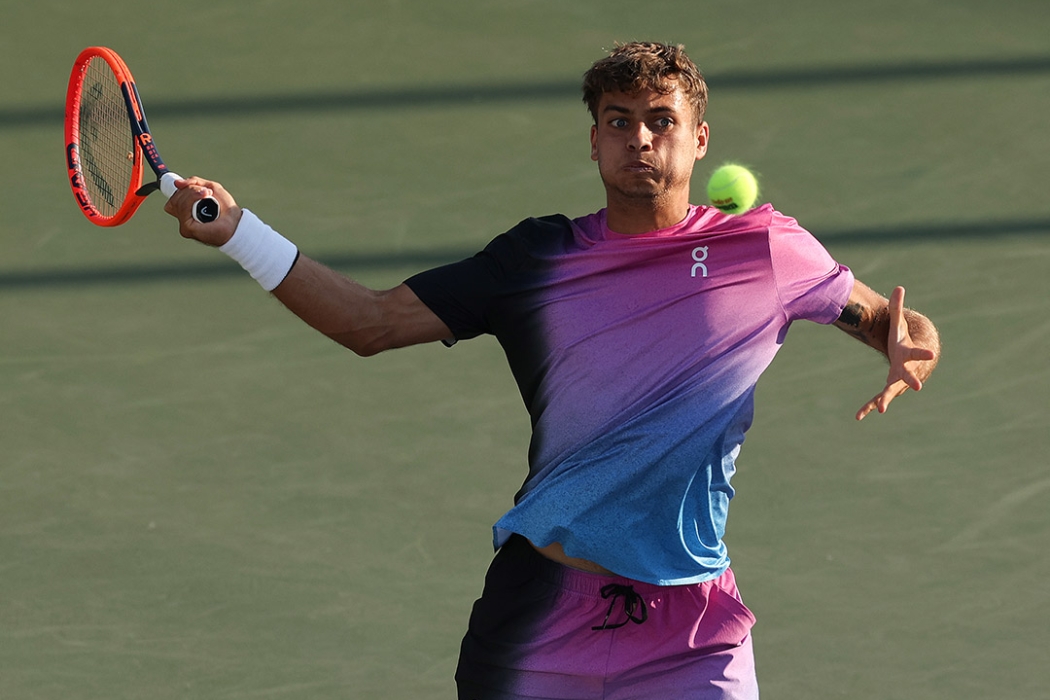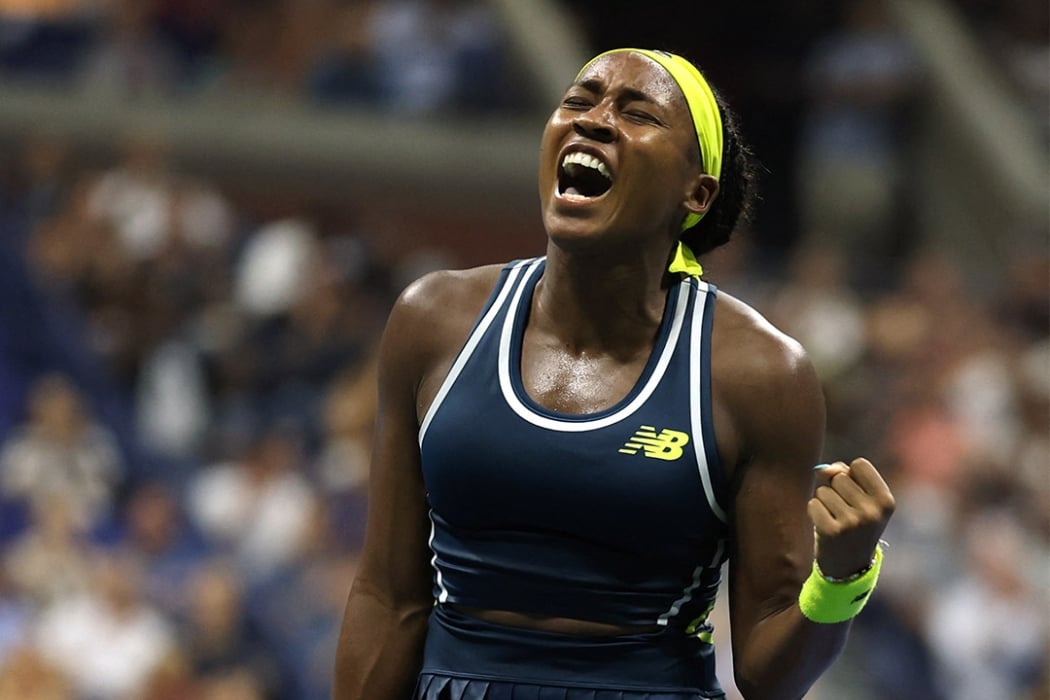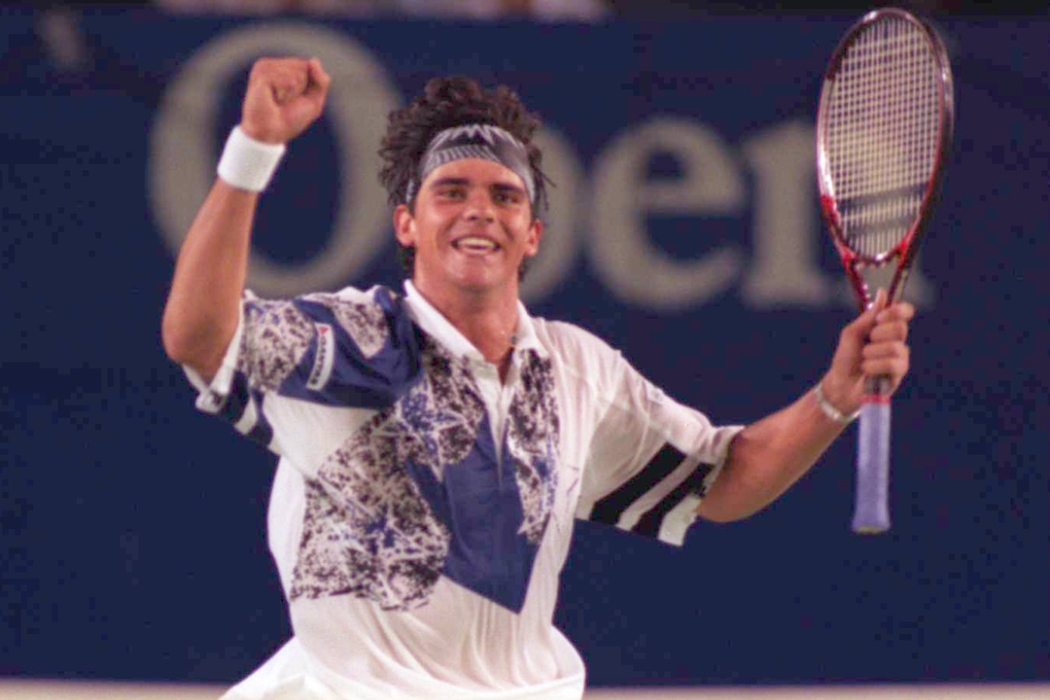It seems that every few years, an Australian player scores a stunning result on the Grand Slam stage.
We saw it again on Friday night at the US Open, when Alexei Popyrin produced one of the biggest results of his career to upstage the legendary Novak Djokovic.
Djokovic, the defending champion, recent Olympic gold medallist and playing for a record 25th Grand Slam title, was described by Popyrin as the greatest of all time.
The Aussie beat him in four sets to advance to the fourth round at a Grand Slam for the first time.
The performance evoked memories of when a similarly-powerful Mark Philippoussis stunned world No.1 Pete Sampras at the Australian Open almost 30 years ago, also in a feature third-round night match.
And that’s where we begin this retrospective, revisiting 10 times less-fancied Australian players outplayed legends of the sport at Grand Slam tournaments.
Mark Philippoussis d Pete Sampras
– Australian Open 1996
Philippoussis was a teenager ranked 40th, coming up against the reigning Wimbledon and US Open champion.
And the young Aussie beat the world No.1 in straight sets under lights at Rod Laver Arena – a match, and result, that helped boost the popularity of Australian Open night sessions.
It had been almost a decade since an Australian man had beaten a world No.1 at a Grand Slam tournament, and Philippoussis completed the upset with incredible explosiveness, overpowering Sampras and sealing the victory with an ace.
“There was excitement that we finally had a big man, playing a big man's game, who could take it to the top players, the Samprases, Beckers and Agassis, fighting fire with fire,” recalled tennis writer and historian Suzi Petkovski.
Jelena Dokic d Martina Hingis
– Wimbledon 1999
This first-round result was one of the greatest upsets in Grand Slam history.
World No.1 Martina Hingis – the reigning Australian Open champion and recent Roland Garros finalist – was expected to comfortably handle Dokic, a 16-year-old qualifier ranked outside the top 100.
Dokic instead humbled the five-time major champion, losing just two games.
"I went out there, and I was on a mission, and I knew exactly how I wanted to play and what I needed to do,” Dokic reflected in an appearance on The Sit-Down podcast.
It was the first big result in a magnificent career for Dokic, who went on to reach the quarterfinals at Wimbledon that year, and the semifinals the following year, and peaked at world No.4 in 2002.
Lleyton Hewitt d Pete Sampras
– US Open 2001
Hewitt was already earmarked as an incredible talent by the time he advanced to the 2001 US Open final.
But he was still relatively inexperienced at the top level, was appearing in his first major final, and confronting Sampras, then a 13-time Grand Slam champion who’d won four US Opens.
Showing almost no sign of nerves, Hewitt dissected the great American in straight sets.
FLASHBACK: Lleyton Hewitt wins 2001 US Open title
Despite Sampras possessing perhaps the most dominant serve the sport had seen, Hewitt’s return was lethal, and he won the second and third sets 6-1 6-1.
“I even had to look up at the scoreboard a couple of times just to check what the score was. It really hadn’t sunk in that I was that far ahead,” Hewitt recalled.
“If there’s ever anyone that you’d want to play in a Grand Slam final, if you were going to win, it was one of the greatest players ever to live.”
Alicia Molik d Venus Williams
– Australian Open 2005
Alicia Molik had never taken a set off Venus Williams in three previous losses to the American, then a four-time Grand Slam champion.
But she entered this fourth-round night match at Rod Laver Arena a changed player, and was convinced she could win.
"It's right up there,” Molik told ausopen.com when asked if this result was her career highlight.
“Because Venus was really close to being at her best then. It was incredibly significant. Not just (beating) Venus; it was the round of 16 at the Australian Open. It also meant so much, because it's on home soil.”
Indeed, Williams went on to win Wimbledon just six months later, making this result all the more significant.
The win propelled Molik into her first Grand Slam quarterfinal, and saw her crack the world’s top 10.
Casey Dellacqua d Amelie Mauresmo
– Australian Open 2008
Prior to AO 2008, Casey Dellacqua had never won a main-draw match at Melbourne Park, losing in the first round for five consecutive years.
This tournament changed everything.
She survived Karin Knapp 8-6 in the third set to end that streak, then upset 15th seed Patty Schnyder by the same scoreline to reach the third round.
There awaited two-time major champion Amelie Mauresmo, the former world No.1 who’d won the AO title just two years earlier.

Yet Dellacqua rode a wave of electrifying support to upstage the Frenchwoman in three sets in an evening classic.
As reported on tennis.com.au, “Dellacqua’s thrilling 3-6 6-4 6-4 win lifted the roof on Rod Laver Arena, with the victory establishing her as Australia’s No.1 female player, moving her into the fourth round of a Grand Slam for the first time, and sparking the run that would see her crack the world’s top 40 later that year.”
Sam Stosur d Justine Henin & Serena Williams
– Roland Garros 2010
There were signs Stosur was becoming a formidable clay-courter when she upset No.4 seed Elena Dementieva en route to the Roland Garros semis in 2009.
But she was at the peak of her powers on the surface in 2010.
In the fourth round that year in Paris she faced the great Justine Henin, a four-time Roland Garros champion who had not lost at the tournament since 2004.
Stosur overpowered Henin in three sets, ending the Belgian’s 24-match winning streak at Roland Garros.

The result set up a quarterfinal against world No.1 Serena Williams, and Stosur beat her too, surviving a match point to clinch a thrilling 6-2 6-7(2) 8-6 victory.
Until Ajla Tomljanovic beat Williams in the legendary American's final match at the 2022 US Open, Stosur had been the only Australian woman to ever beat Serena in a singles match since Williams debuted on tour in the 1990s.
Stosur repeated the feat over Serena in the 2011 US Open final to win her first major singles title.
Nick Kyrgios d Rafael Nadal
– Wimbledon 2014
This result catapulted Nick Kyrgios to superstardom.
At the time he was a teenaged wildcard ranked 144th, and it was already impressive enough he had won through to the fourth round of a Grand Slam for the first time.
There he walked out to play world No.1 Rafael Nadal on Centre Court, and dazzled both the Spaniard, and the millions watching, with his power, daring shot-making and swagger.
Looking right at home on the sport’s grandest stage, Kyrgios completed a memorable 7-6(5) 5-7 7-6(5) 6-3 triumph.
“That's something I'm never going to forget,” he said at the time. “I'm going to draw so much confidence out of that no matter where I play now. To have that under my belt, it's massive.”
He would go on to beat Nadal on another two occasions, and eight years after that initial Wimbledon quarterfinal run, he went all the way to the 2022 final.
John Millman d Roger Federer
– US Open 2018
John Millman had a habit of pushing Roger Federer to the limit.
At the 2018 US Open, the Queenslander reached the last 16 of a major for the first time and came face-to-face with Federer, whom he’d stretched to three sets in Brisbane a few years earlier.
Under lights at Arthur Ashe Stadium, Millman admitted he felt like a “deer in the headlights” initially, before he settled.
And in oppressively thick, humid conditions in New York, Millman ground Federer down in an impressively physical display, overcoming the No.2 seed 3-6 7-5 7-6(7) 7-6(3).
“I'll obviously remember this for a long, long time. I hope the people who are watching here and back home remember it, too,” Millman said after beating the reigning AO champion. “I think that's all part of tennis, sharing the experiences with those close to you. It's extremely special.”
Millman almost beat Federer for a second time at a major, ultimately falling in a fifth-set tiebreak at AO 2020.
Ash Barty d Maria Sharapova
– Australian Open 2019
Ash Barty might have been ranked higher than Maria Sharapova when they met in the fourth round at AO 2019, but this was unchartered territory for the emerging Aussie.
She’d never before beaten Sharapova – a five-time Grand Slam champion – and she’d never before appeared in the second week at her home major.
She was also targeting her first Grand Slam quarterfinal, and was struggling to put the dogged Sharapova away in an increasingly tense final set.
Barty ultimately held her nerve, slotting an ace up the T to complete a 4-6 6-1 6-4 victory.
“That match, if you were to isolate one from the summer, was an indicator of somebody who has gone to another level,” Aussie great Todd Woodbridge observed in the aftermath. “And it’s also an indicator of what’s to come.”
He was right. Just a few months later, Barty broke through for her first Grand Slam title at Roland Garros, and two weeks after that rose to world No.1.
Alexei Popyrin d Novak Djokovic
– US Open 2024
You got the sense this upset was coming, given Popyrin’s form and confidence.
He’d extended Djokovic to four sets in their two previous Slam meetings in 2024 – at the Australian Open and Wimbledon – and was soaring with confidence following his Montreal Masters triumph. There, he beat five top-20 players in a row, including three in the top 10, to win the biggest trophy of his career.
Given Djokovic had shown signs of patchy form in his first two rounds in New York, Popyrin knew this could be his time.
“My two experiences against him earlier this year in Australian Open and Wimbledon kind of gave me the confidence to go out there tonight and believe that I could win and actually do it and believe it,” Popyrin revealed. “So when I did it, it kind of felt that kind of proved me right, proved what I was thinking right.”
It marked Djokovic’s earliest exit from the US Open since 2006, and vaulted Popyrin into the fourth round of a Grand Slam tournament for the first time.



